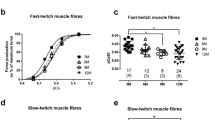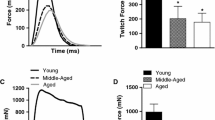Summary
There is indirect evidence for morphologic ‘turnover’ of motor nerve terminals, but the consequences in terms of changing nerve terminal structure throughout mature lifetime are unknown. Therefore, quantitative morphometry of nerve terminals stained with zinc iodideosmium was carried out in soleus and extensor digitorum longus (EDL) muscles of CBF-1 mice at various ages from 5 to 32 months. Because of previous questions as to the role of disuse in producing age changes in nerve terminal structure, locomotor activity was recorded for an average of 20 days continuously in mice spanning the same ages.
The length, area, perimeter and tortuosity of nerve terminals increased either early in maturity (soleus) or progressively with age (EDL). Another prominent change, i.e. increased numbers of nerve terminal ‘regions’ (branches or boutons that are spatially separate or only connected by fine nerve filaments) per junction, only appeared late in life (at or after 25 months). This regionalizatitm was characteristic of all terminals and involved a redistribution rather than an accretion of nerve terminal area. None of the morphological changes with age sufficiently account for previously reported physiologic findings in the same muscles. Locomotor activity (including peaks and troughs of daily activity and circadian rhythm) was not significantly altered over the period of mature lifetime in which nerve terminals were remodelling; therefore, disuse was not a factor in this process. However, slightly retarded and smaller age changes in soleus than in EDL nerve terminals may reflect a modifying effect of activity. It is inferred that two major processes account for morphologic alterations in nerve terminals of mature mice: changes that are simple continuations of normal development and late changes that reflect newly arising age-dependent extrinsic or intrinsic factors.
Similar content being viewed by others
References
Akert, K. &Sandri, C. (1968) An electron microscope study of zinc iodide/osmium impregnation of neurones.Brain Research 7, 286–95.
Banker, B. Q., Kelly, S. S. &Robbins, N. (1983) Neuromuscular transmission and correlative morphology in young and old mice.Journal of Physiology 339, 355–77.
Barker, D. &Ip, M. C. (1966) Sprouting and degeneration of mammalian motor axons in normal and deafferented skeletal muscle.Proceedings of the Royal Society of London, Series B 163, 538–54.
Bennett, M. R. &Raftos, J. (1977) The formation and regression of synapses during the reinnervation of axolotl striated muscles.Journal of Physiology 265, 261–95.
Bevan, S. &Steinbach, J. H. (1977) The distribution of alpha-bungarotoxin binding sites on mammalian skeletal muscle developingin vivo.Journal of Physiology 267, 195–213.
Brooke, M. H. &Engel, W. K. (1969) The histographic analysis of human muscle biopsies with regard to fiber types. 1. Adult male and female.Neurology 19, 221–33.
Brown, M. C., Holland, R. L. &Hopkins, W. G. (1981) Motor nerve sprouting.Annual Review of Neuroscience 4, 17–42.
Buell, S. J. &Coleman, P. D. (1981) Quantitative evidence for selective dendritic growth in normal human aging but not in senile dementia.Brain Research 214, 23–41.
Cardasis, C. A. (1983) Ultrastructural evidence of continued reorganization at the aging (11-26 months) rat soleus neuromuscular junction.Anatomical Record 207, 399–415.
Cardasis, C. A. &Padykula, H. A. (1981) Ultrastructural evidence indicating reorganization at the neuromuscular junction in the normal rat soleus muscle.Anatomical Record 200, 41–59.
Coleman, G. L., Barthold, S. W., Osbaldiston, G. W., Foster, S. J. &Jonas, A. M. (1977) Pathological changes during aging in barrier-reared Fischer 344 male rats.Journal of Gerontology 32, 258–78.
Courtney, J. &Steinbach, J. H. (1981) Age changes in neuromuscular junction morphology and acetylcholine receptor distribution on rat skeletal muscle fibres.Journal of Physiology 320, 435–47.
Elias, P. K., Elias, M. F. &Eleftheriou, B. E. (1975) Emotionality, exploratory behavior, and locomotion in aging inbred strains of mice.Gerontologia 21, 46–55.
Fagg, G. E., Scheff, S. W. &Cotman, C. W. (1981) Axonal sprouting at the neuromuscular junction of adult and aged rats.Experimental Neurology 74, 847–54.
Fahim, M. A. &Robbins, N. (1982) Ultrastructural studies of young and old mouse neuromuscular junctions.Journal of Neurocytology 11, 641–56.
Fahim, M. A., Holley, J. A. &Robbins, N. (1983) Scanning and light microscopic study of age changes at a neuromuscular junction in the mouse.Journal of Neurocytology 12, 13–25.
Fahim, M. A., Holley, J. A. &Robbins, N. (1984) Topographic comparison of neuromuscular junctions in mouse slow and fast twitch muscles.Neuroscience 13, 227–35.
Finch, C. E. (1976) The regulation of physiological changes during mammalian aging.Quarterly Review of Biology 51, 49–83.
Fischbach, G. D. &Robbins, N. (1969) Changes in contractile properties of disused soleus muscles.Journal of Physiology 201, 305–20.
Grinnell, A. D., Herrera, A. A. &Wolowske, B. (1983) Ultrastructural correlations of differences in synaptic effectiveness at frog neuromuscular junctions.Society for Neuroscience Abstracts 9, 1026.
Jakubczak, L. F. (1970) Age differences in the effects of water deprivation on activity, water loss and survival of rats.Life Sciences 9, 771–80.
Kelly, S. S. &Robbins, N. (1983) Progression of age changes in synaptic transmission at mouse neuromuscular junctions.Journal of Physiology 343, 375–83.
Komiya, Y. (1981) Growth, aging and regeneration of axon and slow axonal flow. InNew Approaches to Nerve and Muscle Disorders: Basic and Applied Contributions (edited byKidman, A. D., Tompkins, J. K. &Westerman, R. A.), pp. 173–84. Amsterdam: Excerpta Medica.
Navarrete, R. &Vrbova, G. (1980) Electromyographic activity of rat slow and fast muscle during post-natal development.Journal of Physiology 305, 33–4P.
Nudell, B. M. &Grinnell, A. D. (1983) Regulation of synaptic position, size and strength in anuran skeletal muscle:Journal of Neuroscience 3, 161–76.
Pachter, B. R. &Eberstein, A. (1984) Neuromuscular plasticity following limb immobilization.Journal of Neurocytology 13, 1013–25.
Pearse, A. G. E. (1972)Histochemistry: Theoretical and Applied, Vol. 2. Baltimore: Williams & Williams.
Pestronk, A., Drachman, D. B. &Griffin, J. W. (1980) Effects of aging on nerve sprouting and regeneration.Experimental Neurology 70, 65–82.
Rosenheimer, J. L. &Smith, S. O. (1985) Differential changes in the end-plate architecture of functionally diverse muscles during aging.Journal of Neurophysiology 53, 1567–81.
Slack, J. R. &Hopkins, W. G. (1982) Neuromuscular transmission of terminals of sprouted mammalian motor neurones.Brain Research 237, 121–35.
Smith, D. O. &Rosenheimer, J. L. (1982) Decreased sprouting and degeneration of nerve terminals of active muscles in aged rats.Journal of Neurophysiology 48, 101–9.
Sprott, R. I. &Eleftheriou, B. E. (1974) Open-field behavior in aging inbred mice.Gerontologia 20, 155–62.
Wernig, A., Pécot-Dechavassine, M. &Stover, H. (1980) Sprouting and regression of the nerve at the frog neuromuscular junction in normal conditions and after prolonged paralysis with curare.Journal of Neurocytology 9, 277–303.
Wernig, A., Carmody, J. J., Anzil, A. P., Hansert, E., Marciniak, M. &Zucker, H. (1984) Persistence of nerve sprouting with features of synapse remodelling in soleus muscles of adult mice.Neuroscience 11, 241–53.
Author information
Authors and Affiliations
Rights and permissions
About this article
Cite this article
Robbins, N., Fahim, M.A. Progression of age changes in mature mouse motor nerve terminals and its relation to locomotor activity. J Neurocytol 14, 1019–1036 (1985). https://doi.org/10.1007/BF01224810
Received:
Revised:
Accepted:
Issue Date:
DOI: https://doi.org/10.1007/BF01224810




